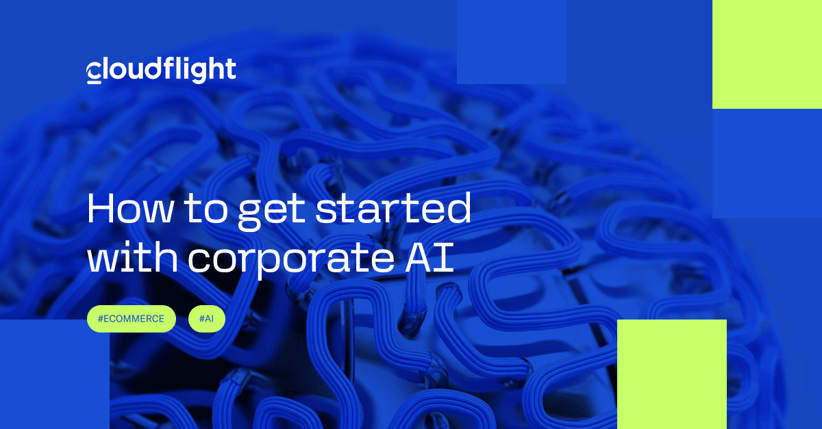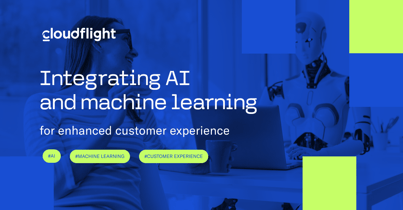The most recent major tech disruption of our times can be intimidating at times. The IT market has cheerfully adopted the artificial intelligence (AI) buzzwords, and you can hardly find a modern tech solution that doesn’t boast about using it in its offering. While it might be tempting to tap into that trend right away, the efficient leveraging of AI requires a deeper understanding of how it works and how it solves some modern business issues.
Let’s go beyond the basic AI spell checkers, search, and chatbots. You’ll hardly find a better way to introduce an impactful AI solution in your company than a well-targeted, budget-efficient project with a major positive impact on one of your KPIs. It will showcase to your organization what the possibilities are and get them hungry for potential further changes and optimization possibilities.
Based on our experience, we’ve pinned down three potential projects that you can quickly implement to get that process started. They are the low-hanging fruits of AI solutions that can bring about instant improvements in your business by cutting your costs, personalizing user experience, and optimizing your processes.
You can find an in-depth analysis in our new eBook “Kickstarting corporate AI.” It contains three basic use cases prepared by our experts.
In this blog post, we share some of our insights on the most efficient approach to implementing an AI solution in your company.
Defining potential areas to optimize with AI
Let’s start with an overview of the benefits AI offers. It’s crucial to understand how AI can impact your processes to realize what can and can’t be done. Referring to our whitepaper, there are six crucial improvements that are easy to achieve in an initial implementation. They’re focused on business efficiency, cost reduction, and innovation.
1. Process automation
AI-powered automation frees up human resources from mundane and repetitive tasks, such as cross-checking documents, preparing product descriptions, or processing data. This reduces operational costs and allows employees to focus on more strategic and creative aspects of their roles.
2. Improved decisionmaking
AI algorithms analyze large datasets, extract meaningful insights, and provide decision-makers with valuable information. This facilitates data-driven decision-making that leads to more accurate and informed choices across various business functions.
3. Streamlining processes
AI optimizes and streamlines business processes, eliminates inefficiencies, and reduces operational costs. This is particularly evident in areas such as supply chain management, logistics, and manufacturing where AI-driven predictive analytics enhance resource allocation and demand forecasting.
4. Predictive maintenance
In sectors such as manufacturing and utilities, AI-driven predictive maintenance minimizes downtime and reduces costs associated with unscheduled equipment failures. Sensors and machine learning algorithms predict when equipment is likely to fail, enabling proactive maintenance.
5. Product and service innovation
AI helps organizations develop innovative products and services. For example, companies use natural language processing (NLP) to create intelligent virtual assistants or leverage computer vision for augmented reality (AR) applications. These both enhance the user experience and make it possible to quickly embrace new market trends.
6. Accelerating research and development
AI expedites the research and development process by analyzing vast datasets and identifying patterns. Pharmaceutical companies, for instance, use AI to discover new drug candidates and streamline the drug development pipeline.
If any of those points strike a chord with you, it might be a good entry point for your first AI solution implementation. Now, let’s look at where to start to make it happen.
How to improve the chances for a successful AI solution implementation and lower its costs
“Introducing AI at your company might seem to be a daunting task at first, but in fact, if your IT architecture is reasonably modern, those three solutions can be easily plugged into your system."
Our eBook presents the basic requirements for each basic AI use case. They are not a strict set of prerequisites because every custom implementation focuses on different KPIs, and you can always find a workaround. Instead, you can use this list as a reference point for what elements are useful to smoothly implement an AI solution. Here are the requirements that can set the stage for your specific AI project.
Defining the specifications of your company's data and potential queries
A robust data infrastructure is the backbone of an effective AI-powered knowledge base. In our implementations, we usually ask the following questions to assess how complex the solution needs to be:
- Does anything stand out in the data used by your company? For example, is it important to have a lot of numerical data represented or tables in the AI responses?
- Does your data have a mix of languages?
- Is your data a mix of file formats? Are there scanned documents that might require optical character recognition (OCR)? Are there any specific headers that are important, such as, for instance, on forms or resumes?
- Is there a lot of data? Is it difficult to access?
The complexity of the solution grows with every positive answer. A more complex and inconsistent knowledge base requires additional AI training. Because of all these factors, you should consider implementing AI for datasets that are the simplest and most polished, and then move on to more complicated fields.
Modern IT architecture
The success of this use case hinges on modern IT architecture. If your systems are outdated, consider investing in the necessary upgrades to support the integration of AI technologies seamlessly.
At the same time, if you are considering investing in AI solutions, we recommend double-checking the basics to make sure your architecture is safe, secure, and efficient.
Quality data
A robust dataset comprised of diverse content is essential. This information serves as the foundation for AI models to ensure they understand the nuances of your brand voice and industry-specific language. To make it consistent, establish clear brand guidelines that the AI-generated content must adhere to. This includes tone, style, and key messaging to maintain a cohesive brand identity across all communication channels.
At the same time, if you want to get a basic proof of concept, you don’t need to train your own model from scratch. Try prompting ChatGPT to test it on the biggest and most expensive model available. If it works fine but becomes too expensive to scale, you can fine-tune a smaller model for your company.
Rich data resources
To ensure the quality of its response, the system needs access to a comprehensive database of customer queries, historical interactions, and common resolutions to problems. The effectiveness of automated systems relies on the pool of data to draw insights from.
If you already have the AI knowledge in your company from the first use case mentioned in this whitepaper, we can easily extend it to look through the documents and automatically detect the necessary information.
Data security measures
Since the knowledge base deals with sensitive corporate information, robust security measures must be in place. Encryption, access controls, and compliance with data protection regulations are non-negotiable.
Additionally, the key question is how privacy sensitive the data is. For example, medical or legal data will be handled differently than less sensitive data. It also enforces a more local approach to the solution’s architecture. It’s difficult to assure privacy if you want to feed an external GPT with your data.
Creative collaboration
If you want AI to generate content, foster collaboration between your content creators and AI systems. While AI can generate content efficiently, human input remains crucial for maintaining accuracy, brand identity, tone, and creativity.
Where to start? The first steps to build a corporate AI strategy
Hopefully, this article has been helpful in understanding how to take the first steps toward your AI implementation. The next steps are exploring proven use cases and honing your vision to the point where you can introduce it to the rest of your company.
You can deepen your knowledge with “Kickstarting corporate AI.” The main goal behind writing this eBook was to help leaders like you introduce their very first AI project within their companies.
If you’re already a step further and need an ally to help you assess your company’s needs and AI maturity, reach out to our experts. We’re ready to support your digital transformation and open ways to benefit from innovative technologies and AI.
Published February 7, 2024












